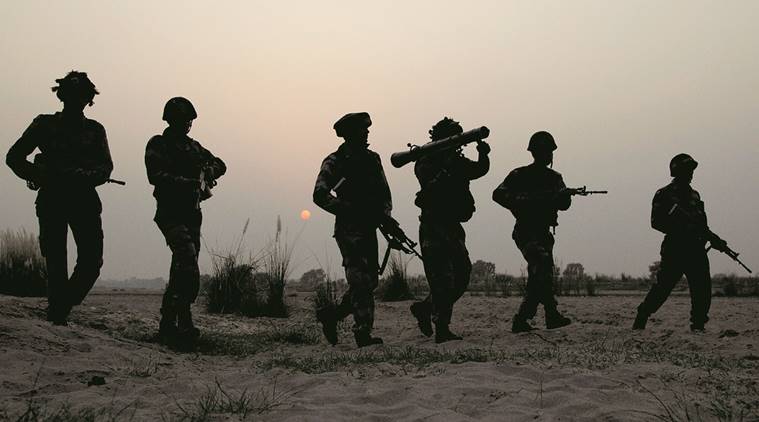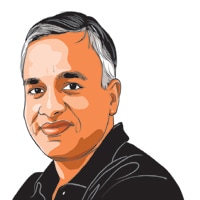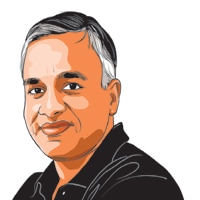What the video conceals
Calculated release of videos of surgical strikes serves political, not military, ends.

Leave alone successful military operations in 1948, 1965, 1971 or 1999, even the Special Forces have had greater successes in various tactical operations.
The immediate provocation for the unofficial release of the army’s video of the surgical strikes of September 2016 to multiple television channels last Wednesday is not known: Pakistan seems gripped by its theatre of elections and the ceasefire along the Line of Control (LoC) has been restored by both sides. Educated guesses vary — from the belief that it was a response to former Union minister Arun Shourie calling them “farzical strikes” a couple of days prior, to an attempt by the government to wrest the narrative on Kashmir after the BJP’s sudden breakup with the PDP.
The surgical strikes were launched by the Special Forces of the army following the death of 19 soldiers in a terror attack at Uri military camp. That was the worst ever loss of soldiers in a single incident in Kashmir.
Lt General D S Hooda (retd), the then Northern Army Commander, who was directly in-charge of the surgical strikes, later told this newspaper that one of their aims was to send a message to the larger public to keep the faith in the army. The other aim was to avenge the death of 19 soldiers and send a message across the border. At an operational level, this allowed the army to professionally test itself by crossing the heavily-guarded LoC and hit the Pakistan army. The latter two aims did not need a public announcement and would have been achieved by keeping the surgical strikes covert, as had been done with trans-LoC operations in the past.
To inform the public, the success of the operation needed to be announced, which was done by the DGMO next morning in Delhi. The language was carefully chosen — he only stated that an operation was carried out “along the LoC”, not across the LoC — and no details were given out. The sanctity of the LoC as a de facto “international border” has been a thorny question for India: It was the argument used by the Atal Bihari Vajpayee government to globally isolate and pressure Pakistan when its soldiers crossed the LoC at Kargil. The Vajpayee government, in fact, passed orders that the army and air force were not to cross the LoC under any circumstances.
That the video has not been officially released by the government — although it has been verified as being real by General Hooda — but only attributed to sources is also due to this reason. New Delhi does not want to officially acknowledge that its soldiers crossed the LoC and give Pakistan a winning diplomatic argument, were Islamabad to try another misadventure across the LoC.
While the video of surgical strikes was not officially released by the government, it was given an imprimatur by the ruling party when it put out the video on social media platforms, mixed with clips of Prime Minister Narendra Modi. It aimed to transfer the credit for a tactical action’s success from the Army to the top political leadership, where no strategy was clearly involved. Avenging the death of soldiers or conducting a risky military operation without any casualties is a plus for the Army. But if the strategic aim was to deter Pakistan from sending terrorists across the LoC, end terror attacks on military camps in J&K or improve the situation in Kashmir — as it ought to be for the top political leadership — the surgical strikes failed miserably. We need to clearly understand the difference between tactical success and strategic failure, and the national institutions responsible for the two domains.
Leave alone successful military operations in 1948, 1965, 1971 or 1999, even the Special Forces have had greater successes in various tactical operations. To inflate the surgical strikes to the level of a 1971 victory, where the Pakistan army signed a document of surrender, is senseless but the hype and hyperbole on some TV channels seem to suggest so. It does a great disservice to not just to our armed forces, which are currently struggling with outdated equipment and a shortage of funds for modernisation, but also to our military veterans.
The armed forces need to be lauded by the public but they need to be supported by the government to be professionally prepared. The easy liberation of Goa in 1961, seen as a great military victory, created a perception of army’s professional invincibility which came crashing down against the Chinese a year later. That should be a lesson for us — not to be lulled into false confidence. Release of videos of tactical actions on demand may help build up a political leader electorally but it is not a substitute for building a professional military and a realistic diplomacy, backed by sound political strategy. What the video conceals is more worrying than what it shows.
sushant.singh@expressindia.com
For all the latest Opinion News, download Indian Express App
More From Sushant Singh
- What India, US would have discussed in ‘2+2’ dialogueThis “2+2” dialogue was meant to replace the Strategic and Commercial Dialogue between the foreign and commerce ministers of the two countries that was held…
- Put on terror funds watch list, Pakistan agrees to action planWill act soon, go after terror groups, says Pakistan; India welcomes move..
- After 2+2 delay, India declines US offer to host Nirmala SitharamanNirmala Sitharaman was slated to follow up the ‘2+2’ meeting on July 6 with a visit to the Pentagon and bilateral talks with US Defence…







































No hay comentarios:
Publicar un comentario